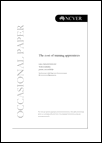Description
This report examines the costs that both employers and apprentices incur for undertaking training in the plumbing and electrical industries. The importance of understanding costs is fundamental. Employers will not take on apprentices if the cost is too high, and prospective apprentices will not undertake an apprenticeship if the future benefits (increased wages) do not outweigh the immediate costs to them. The research found that the apprenticeship model involves a substantial financial commitment from employers, and apprenticeships are more attractive to young people and will remain unattractive to older people, unless the premium paid to qualified tradespeople is substantial.Summary
About the research
Apprenticeships are the time-honoured model for training tradespeople. While there has been some increase in trade apprentices in recent years, there have been parallel concerns that this may not be sufficient to offset current skills shortages, as well as build sufficient stock for future demand. In this context, the report examines the costs that both employers and apprentices incur for undertaking training in the plumbing and electrical industries.
The importance of understanding costs is fundamental. Employers will not take on apprentices if the cost is too high, and prospective apprentices will not undertake an apprenticeship if the future benefits (increased wages) do not outweigh the immediate costs to them (mostly the opportunity cost of alternative jobs).
This report is based on data from six case studies of actual electrical and plumbing apprentices. Although the number of case studies is small, the clarity of the results suggests that they have real salience.
Key messages
- The apprenticeship model involves a substantial financial commitment from employers. The numbers currently involved in training apprentices attests to apprentices’ value to employers.
- The highest costs to employers are for supervision, as apprentice wages are more or less equal to their productivity.
- The effect of government incentives on employers’ decisions to train apprentices is minimal, as they do not represent a significant discount to employers.
- Apprentices also incur costs, based on the loss of potential wages (opportunity cost). The opportunity cost is very sensitive to the alternative wage available to the apprentice.
- Apprenticeships are more attractive to young people (because of lower opportunity costs)
and will be unattractive to older people, unless the premium paid to qualified tradespeople is substantial.
The authors argue that the high cost of apprenticeships will constrain the numbers of employers willing to take on apprentices, especially in a downturn. Therefore, it is worth considering a model which reduces the cost to employers by making more use of institution-based training, so that apprentices require less supervision and are more productive in the workplace. Such a model may not reduce costs overall but would transfer costs from employers to governments and prospective apprentices.
Tom Karmel
Managing Director, NCVER
